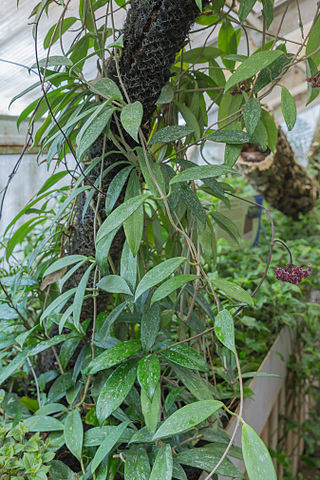
Apocynaceae is a family of flowering plants that includes trees, shrubs, herbs, stem succulents, and vines, commonly known as the dogbane family, because some taxa were used as dog poison Members of the family are native to the European, Asian, African, Australian, and American tropics or subtropics, with some temperate members. The former family Asclepiadaceae is considered a subfamily of Apocynaceae and contains 348 genera. A list of Apocynaceae genera may be found here.

The Asclepiadoideae are a subfamily of plants in the family Apocynaceae. Formerly, they were treated as a separate family under the name Asclepiadaceae, e.g. by APG II, and known as the milkweed family.

Hoya is a genus of over 500 accepted species of tropical plants in the dogbane family, Apocynaceae. Most are native to several countries of Asia such as the Philippines, India, Thailand, Malaysia, Vietnam, Bangladesh, Indonesia, Polynesia, New Guinea, and many species are also found in Australia.

Hoya carnosa, the porcelainflower or wax plant, is an species of flowering plant in the dogbane family Apocynaceae. It is one of the many species of Hoya that are native to Eastern Asia and Australia. It is a common house plant grown for its attractive waxy foliage, and sweetly scented flowers. It is grown well in pots and hanging baskets.
Absolmsia is a genus of flowering plants of the family Apocynaceae of two species, native to Southwest of China and Borneo. The genus commemorates Hermann zu Solms-Laubach.
Dischidia is a genus of plants in the “dog-bane” family Apocynaceae, collectively known as the “milkweeds”. They are epiphytes, native to tropical areas of China, India as well as Bhutan’s southern borders, wherever minimal frost occurs. Additionally, they are known from most areas of Indo-China, including forested areas of Myanmar, Thailand, Vietnam, Cambodia, Laos, and some parts of Malaysia and Singapore.

Cleghornia is a genus of plants in the family Apocynaceae; its various species are distributed in Borneo, China, Laos, Malaysia, Sri Lanka, Thailand, and Vietnam.

Hoya multiflora is a species of tropical plants in the family Apocynaceae. It is found in Indonesia. It is an evergreen perennial plant with a maximum height of 50 centimeters. This plant can produce nectar.

Hoya bilobata, commonly known as wax plant or porcelain flower, is a smaller species of the genus Hoya native to the Philippines. Hoya bilobata is just one of over 200 species of the genus Hoya.
Hoya cutis-porcelana is an endemic species of porcelainflower or wax plant found in Biliran and Samar, Philippines is an Asclepiad species of flowering plant in the dogbane family Apocynaceae described in 2013 by W.Suarez, J.R.Sahagun & Aurigue. Hoya cutis-porcelana belongs to the genus Hoya. There are no subspecies listed.
Hoya aurigueana is an endemic species of porcelainflower or wax plant found in the Quezon province, Luzon, Philippines is an Asclepiad species of flowering plant in the dogbane family Apocynaceae described in 2012 by Kloppenburg, Siar & Cajano. Hoya aurigueana belongs to the genus Hoya. There are no subspecies listed.
Hoya benstoneana is an endemic species of porcelainflower or wax plant found in the Philippines is an Asclepiad species of flowering plant in the dogbane family Apocynaceae described in 2012 by Kloppenburg, Siar, Guevarra & Carandang. Hoya benstoneana belongs to the genus Hoya.
Hoya bicolensis is an endemic species of porcelainflower or wax plant found in the Philippines, an Asclepiad species of flowering plant in the dogbane family Apocynaceae described in 2012 by Kloppenburg, Siar & Cajano. Hoya bicolensis belongs to the genus Hoya.
Hoya persicina is an endemic species of porcelainflower or wax plant found in the Philippines is an Asclepiad species of flowering plant in the dogbane family Apocynaceae described in 2012 by Kloppenburg, et al.. Hoya persicina belongs to the genus Hoya. The species corolla in its flower is peach-colored.
Hoya valmayoriana is an endemic species of porcelainflower or wax plant found in the Philippines, an Asclepiad species of flowering plant in the dogbane family Apocynaceae described in 2012 by Kloppenburg, et al.. Hoya valmayoriana belongs to the genus Hoya. The species corolla in its flower is peach-colored. Originally, this species together with 7 other hoyas, were collected in October 1988 by David M. Cummings(collection number DMC 1622), ¾ kilometer North of Lake Bulusan, in a dense forest along the roadside. The distance of which is from the junction of the main road going along the road towards Lake Bulusan, Sorsogon Province, Philippines - the same location as Hoya davidcummingii Kloppenburg (1995). Mr. Cummings emailed the first author in May 2012 to confirm.
An ant garden is a mutualistic interaction between certain species of arboreal ants and various epiphytic plants. It is a structure made in the tree canopy by the ants that is filled with debris and other organic matter in which epiphytes grow. The ants benefit from this arrangement by having a stable framework on which to build their nest while the plants benefit by obtaining nutrients from the soil and from the moisture retained there.

Hoya bella, the beautiful hoya, waxflower or pretty waxflower, is a species of tropical epiphyte with trailing stems, slightly succulent leaves and pendant umbels of fragrant, white and purple flowers. It is an asclepiad in the periwinkle and milkweed family, Apocynaceae.

Hoya retusa is a species of flowering plant in the genus Hoya native to India and the eastern Himalayas. It is an epiphyte. The plant's specific epithet retusa refers to the shape, with retuse meaning it has a rounded leaf apex with a notch. It grows in a trailing habit and the foliage is succulent.

Hoya pubicalyx is a species of flowering plant in the genus Hoya native to the Philippines. Sometimes confused for Hoya carnosa, it has succulent, lanceolate foliage and grows in a vining habit epiphytically. Kept as a houseplant in temperate climates, it can be found in variegated forms in nurseries. The Philippine five-centavo coin of the New Generation Currency Series features the flowers of this plant.









